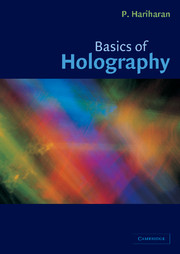Book contents
- Frontmatter
- Contents
- Preface
- 1 Holographic imaging
- 2 The reconstructed image
- 3 Thin and thick holograms
- 4 Light sources
- 5 The recording medium
- 6 Recording materials
- 7 Display holograms
- 8 Multicolor images
- 9 Copying holograms
- 10 Computer-generated holograms
- 11 Applications in imaging
- 12 Other applications
- 13 Holographic interferometry
- 14 Advanced techniques
- 15 Electronic techniques
- Appendix A Interference and coherence
- Appendix B Fourier transforms
- Appendix C Wave propagation
- Appendix D Speckle
- Bibliography
- Index
13 - Holographic interferometry
Published online by Cambridge University Press: 06 July 2010
- Frontmatter
- Contents
- Preface
- 1 Holographic imaging
- 2 The reconstructed image
- 3 Thin and thick holograms
- 4 Light sources
- 5 The recording medium
- 6 Recording materials
- 7 Display holograms
- 8 Multicolor images
- 9 Copying holograms
- 10 Computer-generated holograms
- 11 Applications in imaging
- 12 Other applications
- 13 Holographic interferometry
- 14 Advanced techniques
- 15 Electronic techniques
- Appendix A Interference and coherence
- Appendix B Fourier transforms
- Appendix C Wave propagation
- Appendix D Speckle
- Bibliography
- Index
Summary
Holography makes it possible to store a wavefront and reconstruct it at a later time. As a result, interferometric techniques can be used to compare two wavefronts which were originally separated in time or space, or even wavefronts of different wavelengths. In addition, since a hologram reconstructs the shape of an object with a rough surface faithfully, down to its smallest details, large scale changes in the shape of almost any object can be measured with interferometric precision [Brooks, Heflinger & Wuerker, 1965; Burch, 1965; Collier, Doherty & Pennington, 1965; Haines & Hildebrand, 1965; Stetson & Powell, 1965]. Holographic interferometry is now used extensively in nondestructive testing, aerodynamics, heat transfer and plasma diagnostics [Vest, 1979; Rastogi, 1994] as well as in studies of the behavior of anatomical structures and prostheses under stress [Greguss, 1975; von Bally, 1979; Podbielska, 1991, 1992].
Real-time interferometry
Equations (1.6)–(1.9) show that if a hologram is replaced in its original position in the same optical system used to record it, and illuminated with the original reference wave, it reconstructs the original object wave. If, then, the shape of the object changes slightly, the directly transmitted object wave will interfere with the reconstructed object wave to produce, as shown in fig. 13.1, a fringe pattern that maps the changes in the shape of the object.
- Type
- Chapter
- Information
- Basics of Holography , pp. 112 - 125Publisher: Cambridge University PressPrint publication year: 2002



